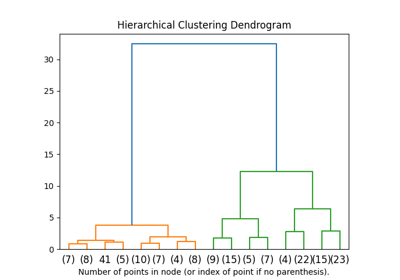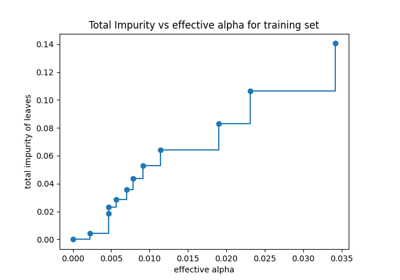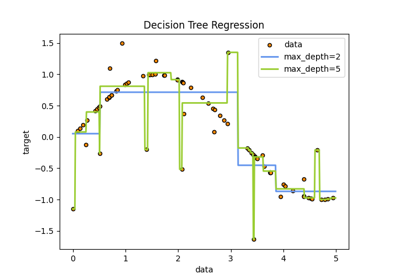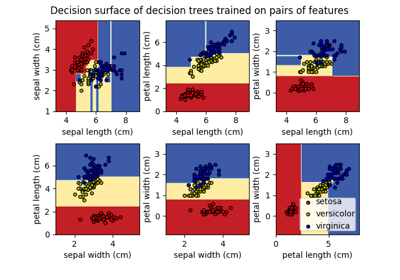备注
Go to the end 下载完整的示例代码。或者通过浏览器中的MysterLite或Binder运行此示例
了解决策树结构#
可以分析决策树结构,以进一步了解特征与要预测的目标之间的关系。在这个例子中,我们展示了如何检索:
the binary tree structure;
每个节点的深度以及它是否是叶子;
样本使用
decision_path方法;使用应用方法获得的样本到达的叶子;
用于预测样本的规则;
一组样本共享的决策路径。
# Authors: The scikit-learn developers
# SPDX-License-Identifier: BSD-3-Clause
import numpy as np
from matplotlib import pyplot as plt
from sklearn import tree
from sklearn.datasets import load_iris
from sklearn.model_selection import train_test_split
from sklearn.tree import DecisionTreeClassifier
训练树分类器#
首先,我们适合 DecisionTreeClassifier 使用 load_iris 数据集。
iris = load_iris()
X = iris.data
y = iris.target
X_train, X_test, y_train, y_test = train_test_split(X, y, random_state=0)
clf = DecisionTreeClassifier(max_leaf_nodes=3, random_state=0)
clf.fit(X_train, y_train)
树结构#
决策分类器有一个名为 tree_ 这允许访问低级属性,例如 node_count 、节点总数,以及 max_depth ,树的最大深度。的 tree_.compute_node_depths() 方法计算树中每个节点的深度。 tree_ 还存储整个二元树结构,表示为多个并行阵列。每个数组的第i个元素保存有关节点的信息 i .节点0是树的根。某些数组仅适用于叶子或分裂节点。在这种情况下,其他类型的节点的值是任意的。例如,数组 feature 和 threshold 仅适用于分裂节点。因此,这些数组中叶节点的值是任意的。
在这些阵列中,我们有:
children_left[i]:节点左子节点的idi如果是叶节点,则为-1children_right[i]:节点右子节点的idi如果是叶节点,则为-1feature[i]:用于拆分节点的功能ithreshold[i]:节点阈值in_node_samples[i]:到达节点的训练样本数iimpurity[i]:节点处的杂质iweighted_n_node_samples[i]:到达节点的训练样本加权数ivalue[i, j, k]:到达输出j和类k的节点i的训练样本的摘要(对于回归树,类设置为1)。请参阅下文以了解有关value.
使用数组,我们可以遍历树结构来计算各种属性。下面,我们将计算每个节点的深度以及它是否是叶子。
n_nodes = clf.tree_.node_count
children_left = clf.tree_.children_left
children_right = clf.tree_.children_right
feature = clf.tree_.feature
threshold = clf.tree_.threshold
values = clf.tree_.value
node_depth = np.zeros(shape=n_nodes, dtype=np.int64)
is_leaves = np.zeros(shape=n_nodes, dtype=bool)
stack = [(0, 0)] # start with the root node id (0) and its depth (0)
while len(stack) > 0:
# `pop` ensures each node is only visited once
node_id, depth = stack.pop()
node_depth[node_id] = depth
# If the left and right child of a node is not the same we have a split
# node
is_split_node = children_left[node_id] != children_right[node_id]
# If a split node, append left and right children and depth to `stack`
# so we can loop through them
if is_split_node:
stack.append((children_left[node_id], depth + 1))
stack.append((children_right[node_id], depth + 1))
else:
is_leaves[node_id] = True
print(
"The binary tree structure has {n} nodes and has "
"the following tree structure:\n".format(n=n_nodes)
)
for i in range(n_nodes):
if is_leaves[i]:
print(
"{space}node={node} is a leaf node with value={value}.".format(
space=node_depth[i] * "\t", node=i, value=np.around(values[i], 3)
)
)
else:
print(
"{space}node={node} is a split node with value={value}: "
"go to node {left} if X[:, {feature}] <= {threshold} "
"else to node {right}.".format(
space=node_depth[i] * "\t",
node=i,
left=children_left[i],
feature=feature[i],
threshold=threshold[i],
right=children_right[i],
value=np.around(values[i], 3),
)
)
The binary tree structure has 5 nodes and has the following tree structure:
node=0 is a split node with value=[[0.33 0.304 0.366]]: go to node 1 if X[:, 3] <= 0.800000011920929 else to node 2.
node=1 is a leaf node with value=[[1. 0. 0.]].
node=2 is a split node with value=[[0. 0.453 0.547]]: go to node 3 if X[:, 2] <= 4.950000047683716 else to node 4.
node=3 is a leaf node with value=[[0. 0.917 0.083]].
node=4 is a leaf node with value=[[0. 0.026 0.974]].
这里使用的值数组是什么?#
的 tree_.value 数组是形状的3D数组 [n_nodes, n_classes, n_outputs] 它提供了到达每个类别和每个输出的节点的样本比例。每个节点具有 value 数组,这是每个输出和类到达此节点的加权样本相对于父节点的比例。
可以将其转换为到达节点的样本的绝对加权数,方法是将此数乘以 tree_.weighted_n_node_samples[node_idx] 对于给定的节点。请注意,本例中不使用样本权重,因此加权样本数是到达节点的样本数,因为默认情况下每个样本的权重为1。
例如,在上面基于iris数据集构建的树中,根节点具有 value = [0.33, 0.304, 0.366] 表明根节点处有33%的0类样本、30.4%的1类样本和36.6%的2类样本。可以通过乘以到达根节点的样本数将其转换为样本的绝对数,即 tree_.weighted_n_node_samples[0] .那么根节点有 value = [37, 34, 41] ,指示根节点处有37个类0样本、34个类1样本和41个类2样本。
穿过树,样本被分裂,结果是 value 到达每个节点的数组都会发生变化。根节点的左子节点具有 value = [1., 0, 0] (或 value = [37, 0, 0] 当转换为样本的绝对数时),因为左子节点中的所有37个样本都来自类0。
注意:在这个例子中, n_outputs=1 ,但树分类器也可以处理多输出问题。的 value 每个节点上的数组将只是一个2D数组。
我们可以将上述输出与决策树的图进行比较。在这里,我们显示到达与实际元素对应的每个节点的每个类的样本比例 tree_.value 阵
tree.plot_tree(clf, proportion=True)
plt.show()
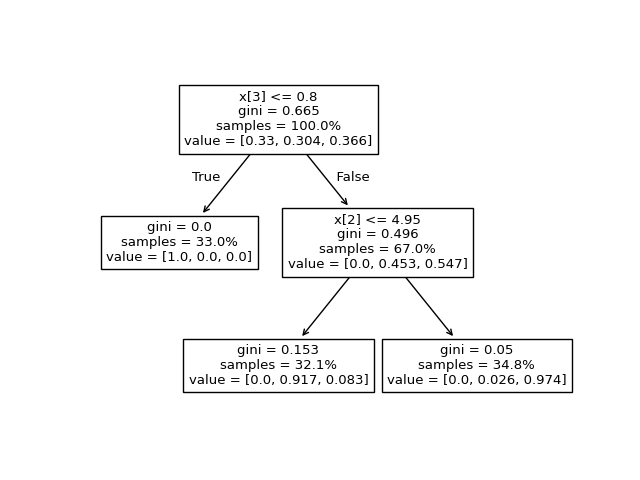
决策轨迹#
我们还可以检索感兴趣样本的决策路径。的 decision_path 方法输出一个指示符矩阵,允许我们检索感兴趣的样本所穿过的节点。指标矩阵中位置的非零元素 (i, j) 表示样品 i 经过节点 j .或者,对于一个样本 i ,行中非零元素的位置 i 指示符矩阵的指定样本经过的节点的id。
可以使用 apply 法这将返回每个感兴趣的样本所到达的叶的节点id数组。使用叶id和 decision_path 我们可以获得用于预测一个样本或一组样本的分裂条件。首先,让我们针对一个样本进行这一操作。注意 node_index 是一个稀疏矩阵。
node_indicator = clf.decision_path(X_test)
leaf_id = clf.apply(X_test)
sample_id = 0
# obtain ids of the nodes `sample_id` goes through, i.e., row `sample_id`
node_index = node_indicator.indices[
node_indicator.indptr[sample_id] : node_indicator.indptr[sample_id + 1]
]
print("Rules used to predict sample {id}:\n".format(id=sample_id))
for node_id in node_index:
# continue to the next node if it is a leaf node
if leaf_id[sample_id] == node_id:
continue
# check if value of the split feature for sample 0 is below threshold
if X_test[sample_id, feature[node_id]] <= threshold[node_id]:
threshold_sign = "<="
else:
threshold_sign = ">"
print(
"decision node {node} : (X_test[{sample}, {feature}] = {value}) "
"{inequality} {threshold})".format(
node=node_id,
sample=sample_id,
feature=feature[node_id],
value=X_test[sample_id, feature[node_id]],
inequality=threshold_sign,
threshold=threshold[node_id],
)
)
Rules used to predict sample 0:
decision node 0 : (X_test[0, 3] = 2.4) > 0.800000011920929)
decision node 2 : (X_test[0, 2] = 5.1) > 4.950000047683716)
对于一组样本,我们可以确定样本经过的公共节点。
sample_ids = [0, 1]
# boolean array indicating the nodes both samples go through
common_nodes = node_indicator.toarray()[sample_ids].sum(axis=0) == len(sample_ids)
# obtain node ids using position in array
common_node_id = np.arange(n_nodes)[common_nodes]
print(
"\nThe following samples {samples} share the node(s) {nodes} in the tree.".format(
samples=sample_ids, nodes=common_node_id
)
)
print("This is {prop}% of all nodes.".format(prop=100 * len(common_node_id) / n_nodes))
The following samples [0, 1] share the node(s) [0 2] in the tree.
This is 40.0% of all nodes.
Total running time of the script: (0分0.055秒)
相关实例
Gallery generated by Sphinx-Gallery <https://sphinx-gallery.github.io> _

